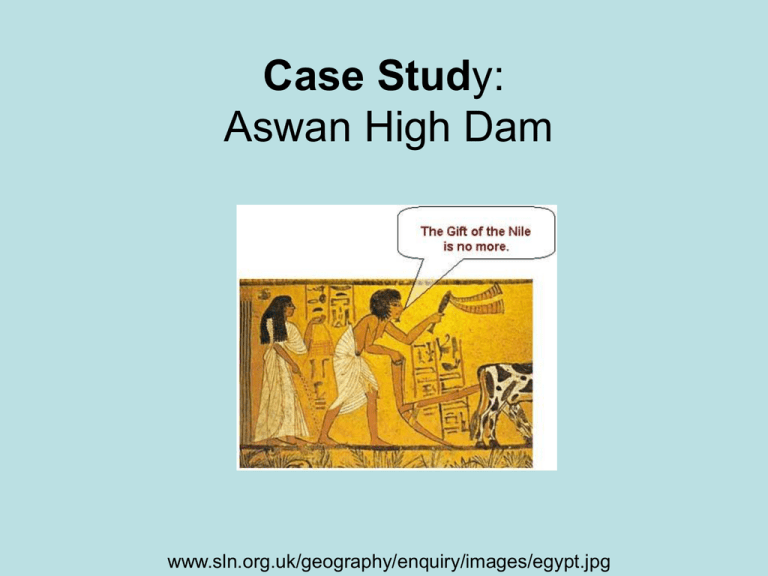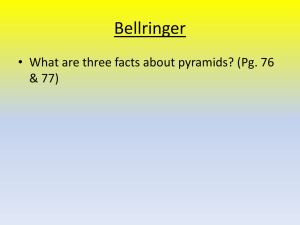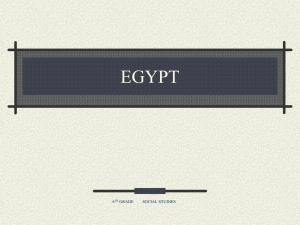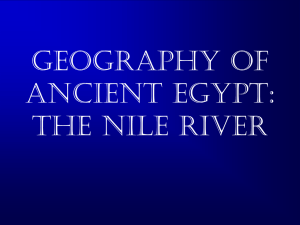Aswan dam ppt
advertisement

Case Study: Aswan High Dam www.sln.org.uk/geography/enquiry/images/egypt.jpg Hail to thee, O Nile! Who manifests thyself over this land, and come to give life to Egypt! Mysterious is thy issuing forth from the darkness. Watering the orchards, to cause all the cattle to live, You give the earth to drink, inexhaustible one! Lord of the fish, during the inundation, You create the grain, you bring forth the barley, Assuring perpetuity to all life. If you cease your toil and your work, Then all that exists is in anguish. If the gods suffer in heaven, then the faces of men waste away. Then He torments the flocks of Egypt, And great and small are in agony. But all is changed for mankind when He comes. He stanches the water from the eyes, and watches over the increase of His good things. Where misery existed, joy now manifests itself. You are the august ornament of the earth, Lifting up the heart of women in labor, And loving the multitude of the flocks. O inundation of the Nile, offerings are made unto you, Men are immolated to you, great festivals are instituted for you. Come and prosper! O Nile, come and prosper! O you who make men to live through his flocks And his flocks through his orchards! Come and prosper, O Nile, come and prosper! Adaptedcome, from an ancient Egyptian hymn to the Nile River. http://www.nilebasin.org/nilemap.htm The Nile • The Nile moves through ten different countries, including Ethiopia, Sudan, Egypt, Uganda, Kenya, Tanzania, Burundi, Rwanda, the Democratic Republic of Congo, and Eritrea. • In 1990 the total population of the Nile basin was estimated at 245 million, with that number expected to reach 859 million by 2025. • Ethiopia contributes 86 percent of the total annual flow of the Nile. The remaining comes from Kenya, Tanzania, Rwanda, Uganda, the Congo and Burundi. Egypt Land and Population Data Total land area: Arable land: Irrigated land: Population: Population Growth Rate: Birth Rate: Death Rate: 1,001,450 sq km 2% 32,460 sq km (1993 est.) 69,536,644 1.69% (2001 est.) 24.89 births/1,000 (2001) 7.7 deaths/1,000 (2001) Benefits of the Dam • Supplys about one-third to one-half of Egypt’s electrical power. • Stores and releases water for irrigation. – Increases food production by allowing yearround irrigation of nearly 8.2 million acres of land. • Provides flood control for the lower Nile basin. • Makes Nile more navigable http://www.internationalegyptology.com/Aswan%20dam%20diagram.gif http://www.kesgrave.suffolk.sch.uk/learningzone/subjects/geography/aswandam.html Disadvantages of the Dam • Ended the yearly flooding that provided the lower Nile basin with nutrient rich silt. – Today, Egypt relies on commercial fertilizers to provide crops with nutrients. • Eliminates 94% of Nile water that once reached the Mediterranean Sea each year. – As a result, the ecology of the water is upset near the mouth of the Nile. • With less water going downstream from the dam, saltwater from the Mediterranean has crept slowly inland. – The salt water mixes with the fresh Nile water and becomes irrigation water. The resulting salinity offsets crop yields. http://www.kesgrave.suffolk.sch.uk/learningzone/subjects/geography/aswandam.html Harmful Results • • • • • • • • • • Loss due to evaporation/seepage 11-15% Sediment against dam not in fields Shrimp industry damaged Increase use of Fertilizers (now over 1mil tons/yr) Downstream shrinkage Increased salinity Damage monuments Schistosomiasis and other diseases increase High dam still floods Political problems Potential Future Problems • In 1997, the Egyptian government began transferring more water for irrigation purposes. • Egypt might soon find itself cut-off from their free water source. – 80% of Lake Nasser water comes from Ethiopia. – Ethiopia and Sudan are considering constructing dams within their own countries. – Many people believe that Egypt would strike militarily at Ethiopia rather than be deprived of any Nile water. Points to Consider • Groups: – Egyptians Farmers – General Egyptian Public – Egyptian Government – Sudanese and Ethiopians – Archeologists, Ecologists and Academicians • Egyptian Farmers and General Public: – Want their homes to stop being flooded annually and when the dam floods – Need silt to be applied to their fields to get a large crop. The alternative is to use expensive, dangerous chemicals. – Want food to be affordable • Archeologists, Ecologists and Academicians – Worried about the loss of the natural environment – The great loss of the historical artifacts at the bottom of the lake and nearby areas • Salt increase is damaging other monuments – Change in course of river • Environmental impacts • Egyptian Government: – The dam stops the annual flooding of the Nile – Provides Egypt with much needed electricity to become an industrialized nation – Worry about Tourist dollars and the damage to national monuments such as the Valley of the Kings and the Great Pyramids. – Egyptian pride for the ability to control a natural force that has ruled the history of the nation. Other Countries • Want to be industrialized • Environmental impacts effect them • Envious of Egypt's prosperity Discussion • Each group will argue their key points before the head of the United Nations. What should be done • High dam currently exists – Downstream countries desire dams as well • Can anyone own a river??? – Who determines the use of a international resource? • Can one country tell another what they can or cannot do? – ex. environmental standards











